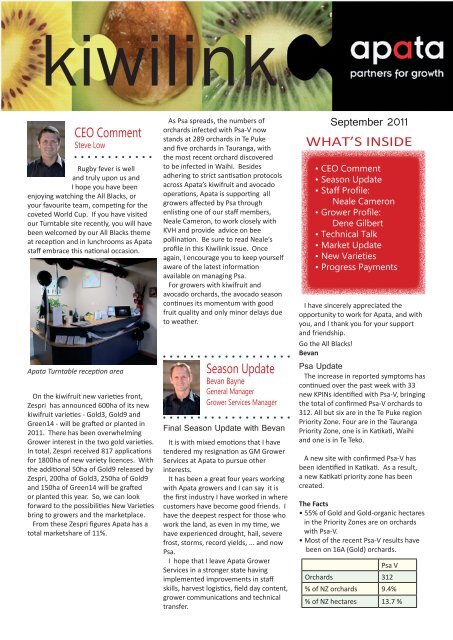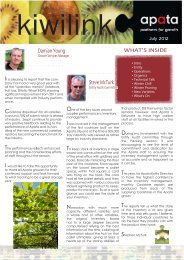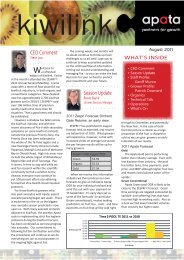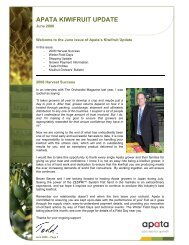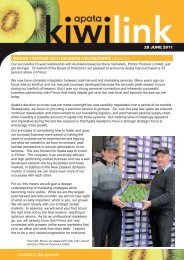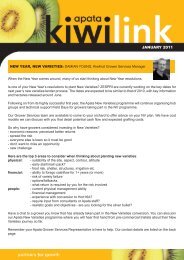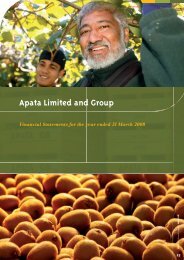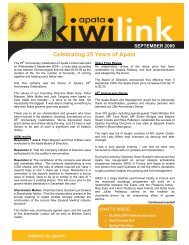Kiwilink - Apata
Kiwilink - Apata
Kiwilink - Apata
You also want an ePaper? Increase the reach of your titles
YUMPU automatically turns print PDFs into web optimized ePapers that Google loves.
kiwilink<br />
CEO Comment<br />
Steve Low<br />
Rugby fever is well<br />
and truly upon us and<br />
I hope you have been<br />
enjoying watching the All Blacks, or<br />
your favourite team, competing for the<br />
coveted World Cup. If you have visited<br />
our Turntable site recently, you will have<br />
been welcomed by our All Blacks theme<br />
at reception and in lunchrooms as <strong>Apata</strong><br />
staff embrace this national occasion.<br />
<strong>Apata</strong> Turntable reception area<br />
On the kiwifruit new varieties front,<br />
Zespri has announced 600ha of its new<br />
kiwifruit varieties - Gold3, Gold9 and<br />
Green14 - will be grafted or planted in<br />
2011. There has been overwhelming<br />
Grower interest in the two gold varieties.<br />
In total, Zespri received 817 applications<br />
for 1800ha of new variety licences. With<br />
the additional 50ha of Gold9 released by<br />
Zespri, 200ha of Gold3, 250ha of Gold9<br />
and 150ha of Green14 will be grafted<br />
or planted this year. So, we can look<br />
forward to the possibilities New Varieties<br />
bring to growers and the marketplace.<br />
From these Zespri figures <strong>Apata</strong> has a<br />
total marketshare of 11%.<br />
As Psa spreads, the numbers of<br />
orchards infected with Psa-V now<br />
stands at 289 orchards in Te Puke<br />
and five orchards in Tauranga, with<br />
the most recent orchard discovered<br />
to be infected in Waihi. Besides<br />
adhering to strict santisation protocols<br />
across <strong>Apata</strong>’s kiwifruit and avocado<br />
operations, <strong>Apata</strong> is supporting all<br />
growers affected by Psa through<br />
enlisting one of our staff members,<br />
Neale Cameron, to work closely with<br />
KVH and provide advice on bee<br />
pollination. Be sure to read Neale’s<br />
profile in this <strong>Kiwilink</strong> issue. Once<br />
again, I encourage you to keep yourself<br />
aware of the latest information<br />
available on managing Psa.<br />
For growers with kiwifruit and<br />
avocado orchards, the avocado season<br />
continues its momentum with good<br />
fruit quality and only minor delays due<br />
to weather.<br />
Season Update<br />
Bevan Bayne<br />
General Manager<br />
Grower Services Manager<br />
Final Season Update with Bevan<br />
It is with mixed emotions that I have<br />
tendered my resignation as GM Grower<br />
Services at <strong>Apata</strong> to pursue other<br />
interests.<br />
It has been a great four years working<br />
with <strong>Apata</strong> growers and I can say it is<br />
the first industry I have worked in where<br />
customers have become good friends. I<br />
have the deepest respect for those who<br />
work the land, as even in my time, we<br />
have experienced drought, hail, severe<br />
frost, storms, record yields, ... and now<br />
Psa.<br />
I hope that I leave <strong>Apata</strong> Grower<br />
Services in a stronger state having<br />
implemented improvements in staff<br />
skills, harvest logistics, field day content,<br />
grower communications and technical<br />
transfer.<br />
September 2011<br />
What’s inside<br />
• CEO Comment<br />
• Season Update<br />
• Staff Profile:<br />
Neale Cameron<br />
• Grower Profile:<br />
Dene Gilbert<br />
• Technical Talk<br />
• Market Update<br />
• New Varieties<br />
• Progress Payments<br />
I have sincerely appreciated the<br />
opportunity to work for <strong>Apata</strong>, and with<br />
you, and I thank you for your support<br />
and friendship.<br />
Go the All Blacks!<br />
Bevan<br />
Psa Update<br />
The increase in reported symptoms has<br />
continued over the past week with 33<br />
new KPINs identified with Psa-V, bringing<br />
the total of confirmed Psa-V orchards to<br />
312. All but six are in the Te Puke region<br />
Priority Zone. Four are in the Tauranga<br />
Priority Zone, one is in Katikati, Waihi<br />
and one is in Te Teko.<br />
A new site with confirmed Psa-V has<br />
been identified in Katikati. As a result,<br />
a new Katikati priority zone has been<br />
created.<br />
The Facts<br />
• 55% of Gold and Gold-organic hectares<br />
in the Priority Zones are on orchards<br />
with Psa-V.<br />
• Most of the recent Psa-V results have<br />
been on 16A (Gold) orchards.<br />
Psa V<br />
Orchards 312<br />
% of NZ orchards 9.4%<br />
% of NZ hectares 13.7 %
<strong>Apata</strong> Grower Services activity in the<br />
last fortnight:<br />
• Attended road meetings – Te Puna,<br />
Omanawa, Waihi, Plummers Point,<br />
Pyes Pa.<br />
• Attending weekly Industry technical<br />
forum.<br />
• Following strict protocols for Avocado<br />
harvest.<br />
• Delivered <strong>Apata</strong> crop protection<br />
programme including Psa focus at<br />
<strong>Apata</strong> field day.<br />
It is vital that ALL growers complete<br />
monitoring regularly on their orchards<br />
and call <strong>Apata</strong> Grower Services if any<br />
sign of Psa is observed. Post harvest<br />
operators have been tasked by KVH<br />
to confirm and record monitoring on<br />
all orchards. To have <strong>Apata</strong> assist this<br />
activity being undertaken on your<br />
orchard at a cost please contact Wade<br />
Hunkin on 027 – 481 9905 or <strong>Apata</strong> 07-<br />
552 0911.<br />
Staff Profile<br />
Neale Cameron<br />
<strong>Apata</strong> Grower Services<br />
Manager<br />
Neale Cameron is <strong>Apata</strong>’s Grower<br />
Services manager for Te Puke east and<br />
resident bee expert. He has a long<br />
history of bee keeping and pollination<br />
expertise ranging from being self<br />
employed in the bee keeping industry<br />
to Quality Manager for KPA, and he was<br />
head of Bee Safe Agrichemical Group.<br />
Neale has been with <strong>Apata</strong> for two years<br />
and has owned and managed a kiwifruit<br />
orchard.<br />
Neale works in an advisory role and is<br />
the point of contact for advice on crop<br />
management, financial information, Psa<br />
and everything to do with the world of<br />
bees such as pollination and bee hive<br />
management. “I really enjoy contact<br />
with growers. I feel like I am trying to do<br />
the very best by my friends – they are<br />
more than growers to me – I have come<br />
to know some growers very well,” says<br />
Neale.<br />
In October 2010, Zespri invited Neale<br />
to join a tour to France to mitigate<br />
a problem between beekeepers<br />
and kiwifruit growers. “It is a highly<br />
emotional time for beekeepers and<br />
growers and I had to remove my<br />
emotions from the situation, so I could<br />
give clear, helpful, advice,” says Neale.<br />
In a similar situation, Neale became<br />
the “link” between two groups in Chile.<br />
He was sponsored by the Chilean<br />
Government, Trade and Enterprise,<br />
and the Chilean beekeeping industry<br />
to spend time advising on issues there.<br />
He successfully helped resolve conflict<br />
between the beekeepers and growers.<br />
It’s not surprising then, that with<br />
Neale’s beekeeping and pollination<br />
expertise he was invited to be an<br />
advisor for KVH (Kiwifruit vine Health)<br />
in the industry fight to protect our<br />
vines from Psa.<br />
“It has been a challenging but<br />
rewarding experience. With KeySprepto<br />
recently released here in the Bay of<br />
Plenty, I’ve had to liaise between<br />
Zespri and beekeepers. Within two<br />
weeks of the issue arising, we formed<br />
a committee that had representatives<br />
from the kiwifruit, avocado and<br />
beekeeping industries. We worked<br />
quickly but effectively to form protocols<br />
that would provide confidence to<br />
everyone concerned.”<br />
<strong>Apata</strong> is very supportive of this<br />
industry approach and keen to play its<br />
part in using whatever resources are<br />
needed to reduce the incidence of Psa.<br />
Neale is working approximately two to<br />
three days a week on KVH projects and<br />
you may see him at meetings, in print,<br />
or in the paper in this role. For more<br />
information on Neale you can visit a<br />
recently posted profile of him on the<br />
KVH website.<br />
In his spare time, Neale likes to play<br />
casual tennis and badminton and has<br />
recently returned to Ceroc dancing,<br />
where he was dancing at “fusion” level<br />
(advanced). He also has two children,<br />
Rachel age 17, and Nicole age 9.<br />
Neale Cameron
Grower Profile<br />
Dene Gilbert<br />
Pyes Pa<br />
Organic Kiwifruit<br />
Kiwifruit orcharding began for Dene<br />
and Yvonne Gilbert in 1978. They<br />
worked as school teachers in Taupo<br />
when they became part of a family<br />
group who began developing a property<br />
in Joyce Road, Pyes, Pa, Tauranga the<br />
following year.<br />
The land had previously been a<br />
dairy farm so hedges and fences<br />
were removed; shelter belts and<br />
subsequently, kiwifruit plants were<br />
planted.<br />
Dene explains how when he started<br />
this first orchard, it was during a time<br />
when no one was trained on the “how<br />
to” of planting and growing vines, or<br />
orchard management, let alone how<br />
to harvest and market fruit. There<br />
were few trained horticulturalists so<br />
we learned through trial and error,<br />
good luck and many visits through<br />
other orchard’s hedge rows. Industry<br />
information was freely shared.<br />
“The kiwifruit industry has enjoyed<br />
years of success in part due to sheer<br />
determination and an assortment of<br />
work experience; it began with such a<br />
diverse range of people, with varying<br />
backgrounds that make up the mix of<br />
talented people today.”<br />
In 1982 Dene and Yvonne partnered<br />
with Graham and Raewyne Cathie and<br />
together they established the Joyce<br />
Road packhouse in Pyes Pa: “We built<br />
the packhouse and coolstore; it was<br />
considered a medium sized operation<br />
then.”<br />
During the mid 1980s, Joyce Road was<br />
packing for Peackock and Cameron,<br />
who developed a lot of the syndicate<br />
commercial orchards in the area. They<br />
were looking for a partner to build a<br />
coolstore and packhouse with. “We<br />
developed a partnernship , which<br />
resulted in joint venture. It was<br />
definitely the right time to be in the<br />
kiwifruit industry as it was expanding<br />
rapidly and there was a real need for<br />
post harvest devleopment,” he says.<br />
Then, in the late 1980s, Peacock<br />
and Cameron sold their interests in<br />
Centrepac to Harvestpac.<br />
“Subsequently, Harvestpac took our 50<br />
percent share in Centrepac but we continued<br />
to run Joyce Road for a number of<br />
years. Later, we closed Joyce Road and<br />
then became shareholders in <strong>Apata</strong> and<br />
our crop was packed at Centrepac.”<br />
He says, “By 1966 organic certification<br />
had been gained on our orchards.<br />
Organics suited the area really well<br />
– here at Pyes Pa. There are lifestyle<br />
blocks all around and it was a good<br />
business decision to convert. Organic<br />
orcharding removes many of the issues<br />
in intensively populated rural areas such<br />
as Hicane.”<br />
Other highlights for Dene as a grower<br />
include seeing the kiwifruit industry<br />
flourish, where now it is a global success.<br />
“We’ve watched the industry grow<br />
and grow to where it’s at now – a large<br />
scale operation. I’ve really enjoyed seeing<br />
New Varieties develop and I think<br />
the overall aims and objectives of the<br />
industry that were set out early on have<br />
worked.”<br />
Dene has also really enjoyed meeting<br />
and being involved with interesting<br />
people that other vocations may not<br />
necessarily lead to. “In a period of a few<br />
days you can interact with everyone<br />
from scientists to marketers, to other<br />
growers, and staff. I’ve had a lot to do<br />
with horticultural research where I’ve<br />
been in direct contact with scientists<br />
– it’s not your average job. There aren’t<br />
many industries where you can interact<br />
with so many sorts of people.”<br />
“The industry has been through difficult<br />
times in the past, particularly during the<br />
early 1990s when there was a major<br />
collapse with supply exceeding demand;<br />
one-third of plantings were pulled out<br />
around the country – many of them<br />
were in marginal areas so the industry<br />
consolidated in to major growing areas.<br />
For a time, land became worth more<br />
without kiwifruit on it. Despite this, we<br />
had a strong belief in the kiwifruit industry<br />
and took the opportunity to expand<br />
our growing base. We now farm 41<br />
canopy hectares, 8 of them are Gold.”<br />
More recently, Dene was approached<br />
to be part of the Tauranga Regional Committee<br />
– a grass roots group of growers<br />
and packhouse representatives – to help<br />
spread the message about Psa. Regional<br />
committees were established to help<br />
share KVH information about Psa and<br />
other relevant information.<br />
“We think sharing knowledge about<br />
Psa is extremely important. As growers<br />
we are committed to doing everything<br />
we can to prevent the disease reaching<br />
more orchards. Besides meetings, we<br />
keep in regular contact.
Grower Profile cont’d.<br />
For example, we email each other new<br />
information the minute we can forward<br />
it on. So, if one of us hears Psa has been<br />
located on a new orchard, we contact<br />
each other as soon as possible,” says<br />
Dene.<br />
He says there is a limited “toolbox”<br />
available for growers. “Growers need<br />
to deal with aspects of Psa that they<br />
can control. Sadly, some growers have<br />
not acknowledged the importance of<br />
implementing preventative protocols<br />
on their orchards. We may not be able<br />
to stop Psa but I think we have to do<br />
everything we possibly can to try and<br />
slow it down, until we find a cure, or<br />
learn to live with it.”<br />
It has been a tough time for all growers<br />
lately. “A year ago the industry outlook<br />
was pretty rosy. Now, we’ve experienced<br />
a huge hiccup and it’s become more<br />
about survival.“<br />
Looking ahead, Dene envisages a new<br />
resistant variety is the logical solution.<br />
He says, hopefully this will have a Zespri<br />
registered PVR associated with it.<br />
But for now, he hopes and plans for<br />
the best. An orchard manager has been<br />
hired who deals specifically with Psa and<br />
Dene’s main aim is quite simple: “I just<br />
want to be able to pick next year’s crop.”<br />
When Dene is not on the orchard he<br />
and his wife Yvonne, enjoy boating and<br />
travel. They have three grown children:<br />
Tamsin works in the BNZ head office<br />
in Wellington, and his other daughter<br />
Emily is a lawyer in Auckland; and the<br />
son that he sees least of, is Hamish, who<br />
is studying towards an MBA in far away<br />
Germany.<br />
On the All Blacks, while a fairly patriotic<br />
man, he says: “They have momentum<br />
at the moment, but they play with an<br />
oval ball. At the end of the day, sometimes<br />
it’s the luck of the bounce.”<br />
Joyce Road Packhouse
WHY IS MONITORING MY ORCHARD<br />
IMPORTANT?<br />
• Rapid response to Psa infection<br />
reduces the risk of spread and<br />
potential vine dieback.<br />
• Orchardists are strongly encour<br />
aged to monitor regularly and<br />
report their findings by email to<br />
the ZESPRI Grower Contact<br />
Centre.<br />
• Leaf spotting can be caused by<br />
other organisms. Lab testing is<br />
required to positively identify<br />
Psa.<br />
• Identifying changes in the level or<br />
degree of symptoms is important.<br />
WHO SHOULD DO IT?<br />
Orchardists are responsible for<br />
ensuring their orchard is monitored<br />
for Psa. APATA can help you with how<br />
to monitor, what to monitor for, and<br />
may also be able to provide resources<br />
to monitor your orchard similar to Pest<br />
monitoring Services provided in summer.<br />
(dependent on location and frequency<br />
required.) This would be a user pays<br />
service.<br />
HOW OFTEN SHOULD I MONITOR?<br />
• Monitoring frequency and<br />
intensity are dependent on<br />
orchard Psa status, location,<br />
variety and time of the year.<br />
• Orchardists should monitor<br />
fortnightly if outside of PZ, or<br />
weekly if within PZ.<br />
• Monitor an orchard by walking<br />
every third row scanning<br />
the canopy for any signs of Psa<br />
symptoms.<br />
• Walk a different set of rows for<br />
each monitoring round (over the<br />
course of 4-6 weeks all rows in<br />
the orchard should be checked<br />
for Psa symptoms.<br />
• Orchardists should remain alert<br />
for signs of Psa at any time<br />
especially during or after cooler,<br />
wetter weather and any<br />
significant climatic events that<br />
give rise to plant injury e.g. wind<br />
storm or hail event.<br />
know your enemy!<br />
WHAT ELSE SHOULD I LOOK FOR?<br />
• Focus on areas of stress in the<br />
orchard e.g. frost pockets, wet<br />
areas, wind damaged areas or areas<br />
that have previously recorded leaf<br />
spot.<br />
• Look for red and clear exudates.<br />
• In some cases it may appear as a<br />
dark colour orange staining (rust)<br />
from where weeping was occurring<br />
and has since dried.<br />
• Cankers may also be beginning to<br />
form in correlation with exudates.<br />
Look for cane dieback where canes<br />
appear dry and dead even though<br />
they are still attached to the parent<br />
vine.<br />
• Mark vines with symptoms with a<br />
coloured tape. Date the tapes and<br />
record the symptoms.<br />
- Establish the level of symptoms in<br />
the immediate vicinity by<br />
monitoring the rest of the block,<br />
walking every row.<br />
- Take a close up digital photo of the<br />
symptoms (or representative<br />
photos if there are a number of<br />
similar symptoms.)<br />
• If any symptoms are seen, confirm<br />
that the symptoms are typical of Psa<br />
by referencing the KVH Winter<br />
symptons Pictorial on the KVH<br />
website<br />
REPORTING OF SYMPTOMS<br />
• Enter monitoring details on the<br />
Symptom Monitoring Sheet (available<br />
from www.kvh.org.nz)<br />
• Ensure the correct contact details<br />
are entered on the monitoring<br />
sheet. (i.e. the person who is going to<br />
accompany the sampler.)<br />
• Email this sheet, along with any<br />
photos taken, to contactcanopy@<br />
zespri.com. It is important to<br />
report both when symptoms have<br />
been observed, and when monitoring<br />
has identified no symptoms.<br />
• Staff will review the photos and<br />
decide if a laboratory test is required.<br />
• You will be advised if a sample is<br />
required from your orchard - or if the<br />
photos do not appear to be Psa.<br />
SAMPLING<br />
• If a sample is required KVH will<br />
arrange for an independent sampler<br />
to visit your property and collect this<br />
sample and you should be advised of<br />
the results of the test within five<br />
days.
Organic Category Report<br />
Andrew Wood<br />
<strong>Apata</strong> Pyes Pa<br />
Organics Manager<br />
Full repack teams are employed at<br />
the Pyes Pa site as we work to meet<br />
current shipping orders. The Joyce Road<br />
coolstores are empty and all staff are<br />
now located at Pyes Pa.<br />
Our Organic Gold inventory has all<br />
been shipped to market, however,<br />
repacking continues at the Pyes Pa<br />
site with 89% of the Organic Green<br />
inventory loaded or on order as at<br />
Week 37. Storage defects are becoming<br />
increasingly evident as time progresses,<br />
but we are moving product quickly<br />
to meet orders as required. We have<br />
current shipping orders for Japan and<br />
ROW, and North American orders are<br />
now complete. Product for China is not<br />
currently on order, which is concerning<br />
at this time. Fruit loss figures to date<br />
are Organic Gold at 1.76% and Organic<br />
Green at 3.21%.<br />
Organics Category: KVH Website<br />
I am pleased to announce the Kiwifruit<br />
Vine Website now has an informative<br />
organic category. You can access it via<br />
www.kvh.org.nz and select “drop-down<br />
box 3”.<br />
On Orchard observations<br />
Technical Talk<br />
Wade Hunkin<br />
<strong>Apata</strong> Technical Advisor<br />
hort16A budbreak has been a little<br />
later than normal and Hayward looks<br />
like being later as well. Neither timing<br />
was unexpected given the warm winter.<br />
However, probably against expectations,<br />
a high proportion of buds have produced<br />
shoots and flower numbers are looking<br />
solid, so overall flower numbers should<br />
not be a problem for most. It will be<br />
interesting to see if Hayward follows the<br />
trend.<br />
PSA Monitoring<br />
The spread of Psa has maintained<br />
its momentum with 33 orchards added<br />
to the list last week alone. While the<br />
numbers appear high it is difficult to get<br />
a good handle on just how significant<br />
the level of infection within the orchard<br />
actually is and what the eventual impact<br />
will be. All were in existing Priority Zones<br />
but there are potential PSA-v finds in<br />
other areas as the recent find in Waihi,<br />
and now Katikati, demonstrates nowhere<br />
is really immune.<br />
There is mounting evidence to<br />
suggest that the situation that has<br />
developed in Te Puke through spring is a<br />
consequence of a false sense of security<br />
in early summer last year. For many<br />
growers outside the immediate intrusion<br />
zone, the threat appeared a long way<br />
away. Coupled with not unreasonable<br />
fears around copper use, resulted in a<br />
lack of real preventative action early<br />
enough. The ‘good news’ out of that is<br />
there is opportunity to protect orchards<br />
that are not already infected.<br />
In the current circumstances,<br />
monitoring is a key component of<br />
our programmes aimed at managing<br />
Psa. At this stage, it appears growers<br />
are managing the task of monitoring<br />
their vines themselves. But, as time<br />
goes on, and the orchard makes other<br />
demands on time and it is important<br />
an appropriate level of monitoring is<br />
maintained.<br />
Psa symptoms will change over the<br />
next few weeks<br />
Until now, we have focused on<br />
searching for exudates and red staining.<br />
That will still be there, but more difficult<br />
spot among the leaves to also look for,<br />
are canes that have not fired properly of<br />
wilted shoots on canes that are properly<br />
connected.<br />
<strong>Apata</strong> Can Help<br />
<strong>Apata</strong> is able to assist growers with<br />
monitoring. We now have a small,<br />
easily expanded group, who can check<br />
your orchard for symptoms on a regular<br />
basis. Charges are on a similar basis to<br />
Kiwigreen monitoring – a per person<br />
hourly rate plus mileage. Contact Wade<br />
or your Grower Services Representative<br />
to discuss.<br />
Crop Protection<br />
Zespri have updated the Crop<br />
Protection programme and sent growers<br />
the wall chart summary. The challenge<br />
now, is in integrating the Psa protective<br />
programme with the insecticides and<br />
fungicides we have traditionally used.<br />
When applying copper sprays<br />
over the period up to flowering,<br />
do not exceed the label rates<br />
for chemical concentrations<br />
and match the water rate with<br />
the amount of canopy that has<br />
developed.<br />
We have heard of examples<br />
where rates have been too high<br />
and some damage, albeit minor,<br />
has occurred.<br />
If in doubt<br />
check the documentation<br />
and your maths!
Technical Talk cont’d.<br />
Organic growers need to note that<br />
Serenade Max has been added to the list<br />
of protective sprays that qualify for the<br />
KVH spray subsidy and only two sprays<br />
are necessary before the subsidy can be<br />
claimed.<br />
Product guidelines for summer have<br />
not yet been finalised, but while there<br />
may be some additional products<br />
becoming available, it is most likely<br />
copper products will remain a significant<br />
option.<br />
Coverage<br />
This is the real challenge for the<br />
summer. At present the majority of<br />
products in the programme are not<br />
systemic, so complete coverage of vine is<br />
imperative.<br />
There are two components of coverage<br />
sprayer setup and canopy configuration.<br />
A recent addition to the KVH website is a<br />
“How to spray guide”. The guide is quite<br />
comprehensive with advice on sprayer<br />
setup and interpretation of chemical<br />
labels.<br />
Until close to flowering time, it should<br />
be a straight forward task to achieve<br />
good coverage, but once the gaps<br />
begin to close it will become more<br />
difficult. Now is the best time to get<br />
that spacing right; even in Gold there is<br />
merit in thinning out any crowded areas<br />
especially given a good floral budbreak.<br />
Look out for the KVH spring spray<br />
kit in the mail. As well as a hard copy<br />
of the guide, it contains a pack of<br />
water sensitive paper to assist you in<br />
assessment of the spray coverage being<br />
achieved in your orchard. Don’t put it<br />
away in the draw – use it. Especially later<br />
in the year when the canopy is full of<br />
water, sensitive paper is the best way<br />
to check how you or your applicator is<br />
going.<br />
Pollination 2011: Things to Remember<br />
Pre-Pollination<br />
• Make sure contracts are in place and stakeholders are aware of<br />
their responsibilities including beehive standards. A good place<br />
to start is the Industry standard which is, 7 frames, 60% Brood at<br />
all stages, 12 frames bees, a laying queen, room for colony<br />
expansion and free of disease.<br />
• Orchard is mown to aid bee orientation on to kiwifruit flowers.<br />
• Prepare a warm and sheltered position for the beehives,<br />
especially given the changeable weather of recent times. This<br />
could include a flagging of position to help bees orientate back<br />
to their hives (a drum or sheet of corrugated iron etc).<br />
• Place mats or platforms on the ground to reduce the risk of<br />
beehives picking up organic matter on bases.<br />
• Reduce orchard movements by consolidating beehive<br />
placements.<br />
• Ensure that beekeepers are aware of the hygiene protocols<br />
and have systems in place; this includes sugar feeding.<br />
During Pollination<br />
• Make sure hives are not introduced too early. Look for at least<br />
10 percent of the female flowers to open before introduction.<br />
And, remember that you are better to be a fraction late than early<br />
because if bees get orientated onto flowers outside the<br />
orchard, you won’t get them back. This will also help reduce<br />
bee foraging area.<br />
• Ensure that sugar feeding is taking place. The recommendations<br />
are two litres every two days at a 60 percent solution. This<br />
increases pollen collection by five or six times.<br />
• Put out a water supply with a piece of sacking in a container of<br />
water.<br />
• <strong>Apata</strong> has Beehive auditing available, so please make sure that<br />
permission to audit is obtained from your beekeeper. To<br />
minimise people movement around the orchard, it is suggested<br />
that auditing be carried out in the event of concerns around<br />
beehive quality.
New Varieties<br />
Damian Young<br />
Kiwifruit GS Manager<br />
From what we are seeing in the new varieties they are following the same pattern as Hort 16a and Hayward<br />
with bud break being behind by 10 to 14 days.<br />
As many of you are experiencing bud break on your New Varieties for the first time it has occurred to me to share what we have<br />
seen on the pre commercial trial sites and what ZESPRI have observed on the clonal blks.<br />
Some Observation of 2011<br />
G9 later than average start to bud break. We are seeing the start of a very good bud break but too early to look at the flower<br />
numbers.<br />
G3 Bud break just starting now on the Hicane blocks it has the promise of a good bud break but history tells us that the bud<br />
break is protracted and has the ability to last more than 3 weeks. G14 Good bud break and from comments I have heard the<br />
flowers are there to have a good start to the growing season.<br />
G3 Start of Bud-break<br />
Early timing may imply increased frost risk if cultivar is suseptible to<br />
cold temperature damage<br />
GOLD3<br />
Site 2008/09 2009/10 2010/11 Av<br />
KK 15 Sep 18 Sep 16 Sep<br />
tP 1 Sep 3 Sep 13 Sep 5 Sep<br />
MK 5 Sep 8 Sep 15 Sep 9 Sep<br />
nn 22 Sep 22 Sep<br />
Av 3 Sep 10 Sep 14 Sep 10 Sep<br />
G3 Start of Bud-break<br />
Early timing may imply increased frost risk if cultivar is<br />
suseptible to cold temperature damage<br />
GOLD3<br />
Site 2008/09 2009/10 Av<br />
KK 3 Oct 29 Aug 15 Sep<br />
tP 27 Aug 26 Aug 27 Aug<br />
MK 5 Sep 24 Aug 30 Aug<br />
nn 8 Sep 8 Sep<br />
Av 11 Sep 30 Aug 4 Sep<br />
SEASON PERFORMANCE<br />
Variety Average TZG Average<br />
Fruit Count<br />
Average<br />
Trays per<br />
hectare<br />
2010 2011 2011 2011<br />
Hort16A 0.63 0.41 32.4 12,300<br />
Hayward 0.63 0.45 33.4 8,700<br />
Gold3 0.54 0.35 28.4 13,700<br />
Gold9 0.84 0.62 31.1 9,580<br />
G3 Start of Flowering<br />
Average date flowering started on canes<br />
GOLD3<br />
Site 2008/09 2009/10 2010/11 Av<br />
KK 31 Oct 23 Oct 30 Oct 28 Nov<br />
tP 24 Oct 30 Oct 02 Nov 29 Oct<br />
MK 21 Oct 29 Oct 30 Oct 26 Oct<br />
nn 9 Nov 10 Nov 9 Nov<br />
Av 25 Oct 30 Oct 30 Oct 29 Oct<br />
G3 Start of Flowering<br />
Average date flowering started on canes<br />
GOLD9<br />
Site 2008/09 2009/10 Av<br />
KK 20 Oct 14 Oct 17 Oct<br />
tP 18 Oct 19 Oct 19 Oct<br />
MK 20 Oct 16 Oct 18 Oct<br />
nn 30 Oct 4 Nov 1 Nov<br />
Av 22 Oct 21 Oct 21 Oct
Wondering who does what? The Grower Forum meets eight times<br />
a year and all growers are welcome to<br />
What is NZKGI?<br />
NZKGI was established as part of the<br />
industry restructure in 1993 to represent<br />
kiwifruit growers and give growers<br />
their own voice in industry and Government<br />
decision making. NZKGI was<br />
formed following the downturn in the<br />
kiwifruit industry in the early 1990’s to<br />
give growers their own organisation to<br />
develop a secure and stable kiwifruit industry.<br />
NZKGI is committed to retaining<br />
the SPE (single point of market entry) to<br />
the benefit of all growers.<br />
The NZKGI Grower Forum consists of<br />
25 Regional and District Representatives<br />
and 12 Industry Group Representatives.<br />
Forum members are elected every three<br />
years by all kiwifruit growers via a postal<br />
ballot.<br />
NZ Kiwifruit Growers Inc belongs to<br />
growers. It is growers looking out for<br />
the interests of growers and is independent<br />
of Zespri and suppliers/post<br />
harvest companies<br />
NZKGI mission (our purpose or why<br />
we exist) “to represent, protect and<br />
enhance the commercial and political<br />
interests of New Zealand kiwifruit growers”.<br />
Our vision is to develop “A strong<br />
grower organisation that demonstrates<br />
industry leadership in which growers<br />
and other industry participants actively<br />
participate”<br />
Key focus area for NZKGI are:<br />
• Membership<br />
• Advocacy<br />
• Communication<br />
• Credible Voice<br />
• Retention of the Single Point of<br />
Entry.<br />
The vision and mission are underpinned<br />
by a set of values governing the operation<br />
of NZKGI and its conduct or<br />
relationships with ZESPRI, Suppliers,<br />
Government, Employees and other<br />
stakeholders.<br />
These are:<br />
• Selflessness<br />
• Ethics<br />
• Objectivity<br />
• Professionalism<br />
• Analysis<br />
• Leadership<br />
attend. The Forum gets briefings from<br />
ZESPRI and Suppliers and debates issues<br />
affecting the Industry.<br />
NZKGI are also involved with the<br />
Green, Gold and Organic Development<br />
Groups where growers have strong input<br />
in discussing issues and developing<br />
new ideas and initiatives to take each<br />
category forward.<br />
These meetings are a central hub for<br />
the debate and formation of a “NZKGI/<br />
Grower View”. These views are then<br />
tabled at the meetings of the Industry<br />
Advisory Council (IAC), the Supply Chain<br />
Committee (SCC) and the Industry Supply<br />
Group (ISG). NZKGI represents growers<br />
at these meetings.<br />
Current funding is by way of authorisation<br />
through the Annual Supply Contract<br />
(between Zespri & suppliers/post<br />
harvest companies). The funds are paid<br />
direct from ZGL to NZKGI.<br />
NZKGI current proposal being voted<br />
on at present (close date 5 September<br />
2011) is to move to a levy funding which<br />
will replace NZKGI’s current funding from<br />
the pools.<br />
What is HortNZ?<br />
Horticulture New Zealand (HortNZ)<br />
is an industry association representing<br />
New Zealand’s 7000 commercial fruit,<br />
vegetable, berryfruit and olive growers.<br />
The industry has a reputation for innovation,<br />
quality, early adoption of new<br />
technology and smart response to market<br />
demand. The industry has a production<br />
area of more than 100,000 hectares.<br />
Major exports include kiwifruit, apples,<br />
avocados, onions, kabocha (pumpkin<br />
squash), processed vegetables and potatoes.<br />
Citrus, berryfruit and olive oil are<br />
developing export products.<br />
HortNZ monitors changes in Government<br />
policy on behalf of our members,<br />
promotes the development of the<br />
horticulture industry, makes submissions<br />
to central and regional government,<br />
gives policy advice and aims to influence<br />
change for the benefit of growers.<br />
HortNZ publishes industry magazines<br />
“The Orchardist” and “Grower” and runs<br />
New Zealand GAP, a quality assurance<br />
programme benchmarked to GLOBAL-<br />
GAP.<br />
The range of issues HortNZ works on<br />
for growers includes resource management<br />
legislation, biosecurity protection,<br />
seasonal and skilled labour recruitment,<br />
environmental policies and industry<br />
education and training. We also provide<br />
information and support to Government<br />
agencies to gain better market access for<br />
horticulture product and remove barriers<br />
to export development.<br />
There are 22 ‘product groups’ affiliated<br />
to HortNZ. These are: pipfruit, kiwifruit,<br />
summerfruit, nashi, citrus, tamarillos,<br />
feijoas, avocados, boysenberries,<br />
strawberries, blackcurrants, blueberries,<br />
kiwiberries, olives, passionfruit, persimmons,<br />
tomatoes, fresh vegetables,<br />
potatoes, kabocha (pumpkin squash),<br />
processed vegetables and asparagus.<br />
HortNZ is funded by growers via a levy<br />
on sales, is governed by a board of eight,<br />
all of whom are growers and operates<br />
with a staff of 20 based in New Zealand’s<br />
capital, Wellington.<br />
All commercial growers of the fruit<br />
and vegetables listed below are legally<br />
required under the Commodity Levies<br />
(Vegetables and Fruit) Order 2007 to<br />
pay a levy on the sale of those fruit and<br />
vegetables grown in New Zealand:<br />
• Fruit (except berryfruit, olives<br />
and grapes)<br />
• Fresh tomatoes<br />
• Fresh vegetables<br />
• Process vegetables<br />
• Potatoes<br />
• Other vegetables (Asparagus,<br />
Kabocha, Process Tomatoes)
Inventory &<br />
Supply Update<br />
Kevin Kerr<br />
G3<br />
There is approximately 570k of gold remaining onshore for which Zespri has taken ownership of after assessments have been<br />
completed to calculate fruit loss. It is still hoped that orders will be issued for approx 350k of this, however any orders will be for<br />
late supply i.e. week 40+.<br />
Green shipments will be the next challenge and currently 1.1m of sizes 39 & 42 have been crop managed. Approximately 3<br />
million trays are scheduled for loadout post week 45, this compared to 260k in 2010. CA packing has now been completed within<br />
the industry.<br />
Market Sales Summary to Week End 36<br />
YTD 2011 YTD 2010 YTD 2009<br />
Green 44.87m 48.25m 47.85m<br />
Green Organic 2.1m 1.93m 1.77m<br />
Gold 27.8m 22.0m 21.95m<br />
The significant figure here is the 4 million extra trays still to ship over and above<br />
2010 plus the large volume of container shipping in the latter part of the season.<br />
GREEN Remaining To Ship<br />
WEEK VOLUME (t/e)<br />
39 – 40 4.42 mill<br />
41 – 43 2.37 mill<br />
44 – 47 2.60 mill<br />
48 – 52 1.05 mill<br />
TOTAL to ship 10.4 mill<br />
Submit Summary InStore<br />
million TE to Week 38<br />
2011 2010<br />
HW1CK 15.1 12.7<br />
HW2CK 0.047 0.044<br />
HW1OB 0.489 0.573<br />
GK1CK 0.570 0.012<br />
GK1OB n/a n/a<br />
Fruit loss estimates for Green were revised again last week<br />
and due to the extended shipping program the figure is now<br />
likely to go over the 6% mark. There is a lot of talk around<br />
SBD in both Gold and Green and the next 2-3 weeks market<br />
outturns for Green will give a strong indication as to whether<br />
or not SBD follows the Gold trend.<br />
There are approx 4 mill trays extra of Green in store than for<br />
same period in 2010 and with the extended time in store<br />
(week 50) fruit loss will almost definitely be higher than last<br />
year.
Progress Payments<br />
The Zespri Board has approved progress payments for the 2011/12 Season for class 1 fruit to be paid on October 14 2011. November<br />
2011 indicative progress payments for class 1 fruit were also approved. Progress payments per tray are detailed in the tables<br />
below.<br />
what’s<br />
on?<br />
KiwiTech Seminars<br />
Lifting Productivity through Improved<br />
Pollination<br />
Thursday 7 October<br />
9am Taruanga RSA (formerly Fahy’s),<br />
1237 Cameron Road, Greerton.<br />
Monday 11 October<br />
2.30pm, Forum North, Rust Avenue,<br />
Whangarei<br />
<strong>Apata</strong> Contact Details www.apata.co.nz<br />
reception@apata.co.nz<br />
Turntable Hill Road, RD2, Katikati<br />
P 07 552 0911 F 07 552 0666<br />
Pyes Pa 83 Pyes Pa Road, Tauranga<br />
07 543 1211 F 07 543 0096<br />
Northland 37 Southend Avenue,<br />
Whangarei<br />
P 09 430 8003<br />
F 09 430 8006


